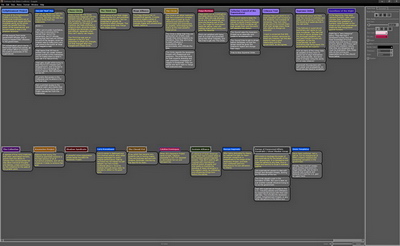I know this is an old thread, but it's also an issue I have struggled with for many years, so I'm going to throw my two-cents worth in on this.
Back when dirt was new, I used Excel for plotting and mind-mapping. It was not very good, but I managed to get by with it as best I could as there wasn't anything else available at the time. In hindsight, I can see that what I was looking for was a software program that worked with the way I think. I believe that is the most important element in finding the right tools. Over the years, I tried everything I could get my hands on but nothing fit the bill. What worked for other writers didn't necessarily work for me as we all think differently.
I wanted something without boundaries. A program that was liquid so to speak. Spreadsheets were too rigid as were hierarchical mind mapping tools. My mind thinks in relationships and clusters, leaping from one cluster to the next. Plotting tools were too rigid and the only thing I got out of them was frustration.
Today, I use Scrivener and Scapple. For me, Scapple has been my god-send. It allows me to plot visually as I see it in my mind. The absence of color-coded linking lines are not a problem for me. Instead, I use the Inspector tool to create a variety of patterned styles. For example, each cluster which represents a scene, has a parent object with my
Parent style. Within the cluster, plot points have a style, cross-links have a style, and hyperlinks to sources have a style. I style important points with a bold contrasting style as attention getters and reminders. In the end, I have a cluster where I can visually recognize every element's function by its style. But there's more, because each parent object is free-flowing, that is not restricted by logic tree hierarchy, I can flow the parent objects anywhere I want (and their child objects with them) as I brainstorm the plot clusters.
That is the key that makes Scapple work for me is its fluidity. It feels like liquid in my mind. Later, I transfer each scene to Scrivener where each scene takes on more structure.
IMO, Scapple's extensive custom style ability makes up for it's lack of color-coded link lines.
For an example, I'll add a screen capture of one of my projects in Scapple.
In the below image, blue represents a Parent or Scene object. White are action points within the scene. Yellow with black are reminders. Yellow with red are plot holes. White on black are depreciated plot points due to rewrite. Cloud shaped red are plot points that link to scenes elsewhere in the story. White backgrounds are unwritten scenes. Beige backgrounds are completed scenes.



